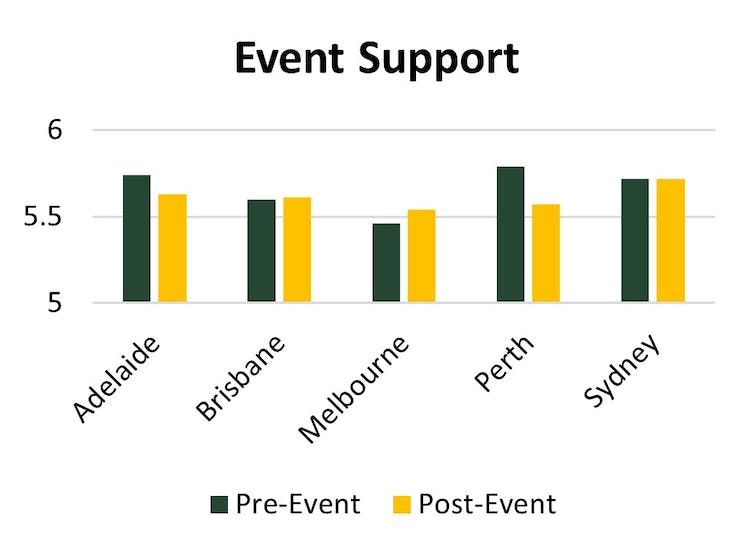No event in Australian history has captured the country’s imagination like the 2023 FIFA Women’s World Cup. From coast to coast, Australians tuned in to witness the Matilda’s historic tournament run, reaching the semi-finals for the first time in the team’s history.
But prior to the Matilda’s historic success, there was much concern throughout Australia. Australians were sceptical about the multi-city event model and what positive impacts they could expect. It didn’t help that just days before the tournament’s opening day, Victoria’s multi-city plan to host the 2026 Commonwealth Games was cancelled.
Cancelling the Commonwealth Games won’t come cheaply – Victoria now faces the legal consequences
Our new research measured the impact of the 2023 FIFA Women’s World Cup on each Australian host city – Adelaide, Brisbane, Melbourne, Perth, and Sydney. Data collected from 2,000 Australians surveyed pre-event (June) and post-event (November) show the event increased Australians’ interest in women’s sport for all cities except Perth. In addition, each city showed greater support for hosting the event in the future, except Adelaide and Perth.
Author supplied, Author provided (no reuse)
Author supplied, Author provided (no reuse)
Australia’s view of the Women’s World Cup
Why were the event outcomes different for all Australian cities? We know that every mega sport event comes with positive and negative impacts for the host nation and its cities. We measured the perceived benefits and costs of hosting the event according to survey participants in terms of economic, environmental, social, and sport participation criteria.
It was surprising to see residents in each host city report post-event that the 2023 FIFA Women’s World Cup had resulted in greater benefits for their communities than they had anticipated. A majority of survey respondents also felt the tournament had incurred lower costs than expected.
These results stand in stark contrast to what is usually expected for an event of this scale, and bodes well for the potential of future multi-city events, such as the Brisbane 2032 Olympics.
Based on the graphs above, it would appear the event was a resounding success for all cities. However, looking beyond the surface of event perceptions, clear winners and losers are found.
Author supplied, Author provided (no reuse)
World Cup winners and losers
Post-event, Brisbane, Melbourne, and Sydney indicated greater support for their respective city hosting the event, while Adelaide and Perth citizens showed a decrease in support. This was unexpected given Adelaide and Perth had the lowest hosting responsibilities of all cities, hosting five games each while Melbourne (6), Brisbane (8), and Sydney (11) hosted more games.
This could suggest Adelaide and Perth citizens felt excluded from the multi-city event model, which favoured more games in other cities. Adelaide and Perth were not initially part of Australia’s bid for the tournament, which was originally slated to be held just in the eastern three cities. They were added after the initial bid development with New Zealand.
Darren England/AAP
Highlighting this divide between Australia’s host cities further are data on Australian’s women sports fandom. Australians in each city except Perth showed an increase in support for women’s sport because of the 2023 FIFA Women’s World Cup.
Women’s sport fandom results showed the biggest jump from pre-to-post event for all other Australian cities. This reveals the true Matildas effect, as we saw a significant increase in support for women’s sport that was not just centred on the team’s historic semi-final run or their ability to draw the largest broadcast audience in Australian history.
Cricket? Lacrosse? Netball? The new sports that might make it to the 2032 Brisbane Olympic Games
The future of global sporting events in Australia
Our research highlights the power that mega sport events have to captivate Australians and trigger social change, but it also reveals opportunities for improvement of the multi-city event model. With so many mega sport events planned in the coming decade in Australia, climaxing with the Brisbane 2032 Olympics, there are two important lessons here, particularly from the survey results coming out of Adelaide and Perth.
First, it is imperative to consider all cities in the multi-city operation, not just the “big ones”. One way this could have been done is by engaging all cities in the 25-day tournament countdown leading to the first match. This would build a sense of unity across the country and spotlight the uniqueness of each city, as opposed to focusing mostly on Sydney.
This will be of paramount importance in the lead-up to the Brisbane 2032 Olympics, which will include several big cities (Brisbane, Melbourne, and Sydney) and several smaller cities (Gold Coast, Sunshine Coast, Cairns, and Townsville). Unless a conscious effort is made to engage each city, no matter their size and location, we may see more fragmented results.
Second, the 2023 FIFA Women’s World Cup was a resounding success, giving Australia and New Zealand hope and scope to consider co-hosting more events in the future.
Building from this multi-city event model, the two countries might look to expand even further, perhaps bidding for a future FIFA Men’s World Cup or the Commonwealth Games.
_This story has been corrected. It initially said Perth hosted 8 games – in fact, that should have been Brisbane. _

